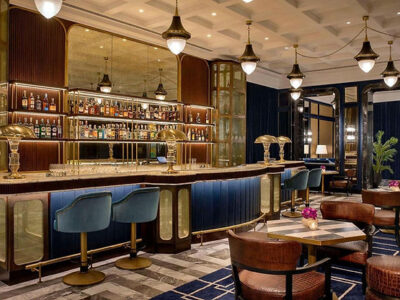
Cairo might be known as the city of a thousand minarets, but old mosques and Pyramids aren’t all that Cairo has to offer when it comes to history.
Coptic Cairo, also known as mogama’ el adyan (Interfaith Complex), is an area unlike any other in Egypt. It’s part of ‘Old Cairo’, the original city center for centuries – and Coptic Cairo, with its fortress, churches and synagogue, predates the actual founding of Cairo by the Muslim Fatimids in 969 AD.
You may also like: El Moez Street – A Detailed Local’s Guide
Coptic Cairo is known as the stronghold of Christianity in Old Cairo, home to places of worship that date back to the time when the pharaonic religions of Ancient Egypt had died out and Islam had not yet arrived. Some of Egypt’s earliest churches remain standing in Coptic Egypt to this day – some dating back to the 4th century AD. It’s also believed that the Holy Family lived here for a short period during their flight into Egypt to escape Herod.
What does Coptic mean exactly?
Coptic refers to Coptic Orthodox Christians, the largest Christian denomination in Egypt and the Middle East as a whole. The Coptic language directly evolved from the Demotic Egyptian language, which was the last language of the Ancient Egyptians. It’s believed the word ‘Copt’ originated from the Ancient Egyptian word Hwt-Ka-Ptah, which means the “House of the God Ptah”. Later, the Greeks used the word ‘Aigyptos’ for Egypt, while Egyptian Coptic Christians used the Coptic term ‘Kyptos’.
Originally, the word ‘Copt’ referred to all Egyptians, but then became associated solely with Coptic Christians after the Islamic conquest of Egypt in 639 AD.
How To Get There

Coptic Cairo is in a congested area of central Cairo, but easily accessible by Uber or car. It’s also one of the very few tourist spots in Cairo that has its own metro stop, called Mar Girgis. So if you wanted to try the metro in Cairo, this might be a good spot to do it.
Otherwise if you’re going by car, then just plug in ‘Mar Girgis’ into your Google Maps and it’ll take you straight to the entrance of the complex.
What To Expect
Coptic Cairo is a relatively enclosed complex, meaning there’s a distinct entrance/exit, heavily monitored by tourism police. Once you enter the complex, it’s all pedestrian, with the remains of the fortress and the big churches on the main path, and the older, smaller churches deeper in the complex, accessed via small alleys. The Coptic cemeteries are towards the back.
Local tip: to avoid crowds, try to visit on a weekday morning, the earlier the better. Domestic tourists that live outside of Cairo tend to visit on the weekends, making it more crowded than usual. Also keep in mind that a few of the churches inside are still operational, and there’s a rec center and wedding hall that go about their usual business, so it’s not *just* a tourist spot.
Coptic Cairo Opening Hours & Entrance Fees

The churches: 8 am – 4 pm
Entrance fee: free
Coptic Museum: 9 am – 5 pm
Entrance fee: 100 EGP for non-Egyptians + 20 EGP for an audio guide (optional)
The main things to see in Coptic Cairo:

Babylon Fortress

One of the first things you’ll see when you enter Coptic Cairo is the ruins of the Babylon Fortress, built on an old Ancient Egyptian town of the same name. Although named after Babylon in Mesopotamia, the fortress was actually built by the Romans around 100 AD, during the Ptolemic era of Ancient Egypt. It was built where a canal connected the Nile to the Red Sea and served as a marker between Upper and Lower Egypt. It was captured by the Arab conquest in 641 AD.
Church of St. George (Mar Girgis)

Established: 10th century
One of the few round churches built in Egypt, St. George’s is built on top of an ancient Roman tower that connects to the monastery below.
The interior of the church is known for its stained glass and rich woodwork.
St. George’s is one of the only still-active churches in the Coptic Cairo area, and is considered the principal Greek Orthodox church in Egypt. Visitors of all religions are welcome any time, except to the monastery, which is closed to the public.
The “Hanging Church” – Coptic Church of St. Virgin Mary

Established: 690 AD
It got the name of ‘Hanging Church’ (or ‘Suspended Church’ in Arabic, ‘El Moallaqa’) because of its location above the fortress gatehouse. When it was first built, the pillars of the gatehouse would have been easily seen, creating the ‘hanging’ effect of the church, but now are buried due to the rise of the ground over the past 1300 years.
The church is believed to be the first basilica style church built in Egypt, and houses 110 icons, most made of ebony and some inlaid with ivory, the oldest and holiest dating back to the 8th century.
Saints Sergius and Bacchus Church (Abu Serga)

Established: 4th century
The Abu Serga church is believed to be not only the oldest church in Egypt, but built on the spot where the Holy Family (Joseph, Mary, and infant Jesus Christ) stopped and rested towards the end of their journey to Egypt. The spot is now the crypt of the church, 10 meters deep.

The cavern underneath Abu Serga Church
It’s also believed that they might have lived here while Joseph was working at the Babylon Fortress.

Abu Serga is also of importance because it’s where many patriarchs of the Coptic Church were elected, the first being Patriarch Isaac in 681 AD.
Ben Ezra Synagogue

Established: 882 AD
Originally a Coptic Church (it’s actually situated right behind the Hanging Church), Abraham Ben Ezra from Jerusalem bought the church and converted it to a synagogue. It’s believed to be the spot where the baby Moses was found.
The synagogue went through a series of renovations over the centuries, with the current structure dating back to 1892. It’s built in the style of a basilica, with two floors: the first floor dedicated to men, and the 2nd dedicated to women.
Due to the huge decline in the Jewish community in Cairo, the synagogue now functions as a museum and a tourist attraction as opposed to an operating place of worship.
Church of St. Barbara

Established: 5th century
The Church of St. Barbara the Martyr is another extremely old church, that was complete with priceless relics that exist until today (although many of them have been moved to the Coptic Museum). Although the church itself has been rebuilt and restored several times, items from the original church are believed to date back to the 5th or even 4th century.
Coptic Museum

Known as the best place to learn about Coptic history in Egypt, this museum hosts over 1,600 pieces, dating back to the early days of Coptic Christianity in the 3rd and 4th century AD.
This museum is known for its bibles written in the 11th and 13th centuries in both Arabic and the Coptic language on deerskin, as well as Christian writings on papyrus dating back to the 6th century.
Other collections of note: its icon display, as well as pottery, glass, metal, wooden and textile collections.
For more really interesting museums to check out in Cairo, head here.
Do I need a guide for Coptic Cairo?
Honestly? Not really. Unless you’re really into details. In our humble opinion, Coptic Cairo is more of a place to walk around, appreciate the centuries-old art and architecture and soak up the spirit of the place without getting bogged down with tour guides or tour groups. But obviously to each their own, some people appreciate places more when they know exactly what they’re looking at and the story behind it, so up to you!
Where to eat/drink in Coptic Cairo
There aren’t any restaurants in the complex besides a cafeteria of sorts, and little kiosks and mini-markets that sell soft drinks and snacks, so don’t plan on eating there. In general the greater area of Old Cairo doesn’t offer the most when it comes to restaurants, so plan to eat before/after visiting the area.
General local tips
- Coptic Cairo is very close to the National Museum of Egyptian Civilization (well, close for Cairo, about 10 minutes by car), so it makes sense logistic-wise to visit these two spots on the same day if you’re planning to see both while in Cairo
- If you’re still hankering to see more Coptic churches, a really gorgeous one is the Cave Church (Monastery of St. Simon the Tanner), which is carved into the Moqattam mountain
- The little alleys of Coptic Cairo have all sorts of books, postcards and other souvenirs, so budget in a little time to browse

Enjoy!
Liked this detailed Coptic Cairo guide? Here are a few more for other popular spots in Cairo:




